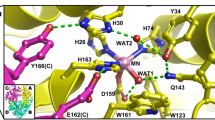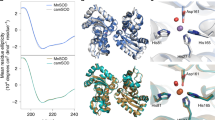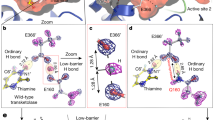Abstract
Electrostatic forces have been implicated in a variety of biologically important molecular interactions including drug orientation by DNA1, protein folding2–3 and assembly4, substrate binding and catalysis5–7 and macromolecular complementarity with inhibitors, drugs and hormones8–11. To examine enzyme–substrate interactions in copper, zinc superoxide dismutase (SOD), we developed a method for the visualization and analysis of an enzyme's three-dimensional electrostatic vector field that allows the contributions of specific residues to be identified. We report here that the arrangement of electrostatic charges in SOD promotes productive enzyme–substrate interaction through substrate guidance and charge complementarity: sequence-conserved residues create an extensive electrostatic field that directs the negatively charged superoxide (O2−) substrate to the highly positive catalytic binding site at the bottom of the active-site channel. Dissection of the electrostatic potential gradient indicated the relative contributions of individual charged residues: Lys 134 and Glu 131 seem to have important roles in directing the long-range approach of O2−, while Arg 141 has local orienting effects. The reported methods of analysis may have general application for the elucidation of inter-molecular recognition processes.
This is a preview of subscription content, access via your institution
Access options
Subscribe to this journal
Receive 51 print issues and online access
$199.00 per year
only $3.90 per issue
Buy this article
- Purchase on Springer Link
- Instant access to full article PDF
Prices may be subject to local taxes which are calculated during checkout
Similar content being viewed by others
References
Dean, P. M. Br. J. Pharmac. 74, 39–46 (1981).
Hol, W. G. J., Halie, L. M. & Sander, C. Nature 294, 532–536 (1981).
Sheridan, R. P., Levy, R. M. & Salemme, F. R. Proc. natn. Acad. Sci. U.S.A. 79, 4545–4549 (1982).
Perutz, M. F. Science 201, 1187–1191 (1978).
Hayes, D. M. & Kollman, P. A. J. Am. chem. Soc. 98, 7811–7816 (1976).
Sheridan, R. P. & Allen, L. C. J. Am. chem. Soc. 103, 1544–1550 (1981).
Warshel, A. & Levitt, M. J. molec. Biol. 103, 227–249 (1976).
Blaney, J. M. et al. J. Am. chem. Soc. 104, 6424–6434 (1982).
Weiner, P. K., Langridge, R., Blaney, J. M., Schaefer, R. & Kollman, P. A. Proc. natn. Acad. Sci. U.S.A. 79, 3754–3758 (1982).
Pullman, B., Lavery, R. & Pullman, A. Eur. J. Biochem. 124, 229–238 (1982).
Friend, S. H., March, K. L., Hanania, G. I. H. & Gurd, F. R. N. Biochemistry 19, 3039–3047 (1980).
Salin, M. L. & Wilson, W. W. Molec. cell. Biochem. 36, 157–161 (1981).
Cudd, A. & Fridovich, I. J. biol. Chem. 257, 11443–11447 (1982).
Koppenol, W. H. in Oxygen and Oxy-Radicals in Chemistry and Biology (eds Powers, E. L. & Rodgers, M. A. J.) 671–676 (Academic, New York, 1981).
Malinowski, D. P. & Fridovich, I. Biochemistry 18, 5905–5917 (1979).
Tainer, J. A., Getzoff, E. D., Richardson, J. S. & Richardson, D. C. Nature (this issue).
Klug, D., Rabani, J. & Fridovich, I. J. biol. Chem. 247, 4839–4842 (1972).
Margerum, D. W., Cayley, G. R., Weatherburn, D. C. & Pagenkopf, G. K. in Coordination Chemistry Vol. 2 (ed. Martell, A. E.) 1–220 (American Chemical Society, Washington DC, 1978).
Hopfinger, A. J. in Conformational Properties of Macromolecules (eds Horecker, B., Kaplan, N. O., Marmur, J. & Scheraga, H. A.) 39 (Academic, New York, 1973).
Gelin, B. R. & Karplus, M. Biochemistry 18, 1256–1268 (1979).
Dearing, A., Weiner, P. & Kollman, P. A. Nucleic Acids Res. 9, 1483–1497 (1981).
Connolly, M. L. Science 221, 709–713 (1983).
Weiner, P. K. & Kollman, P. A. J. comp. Chem. 2, 287–303 (1981).
Adams, D. J. Chem. phys. Lett. 62, 329–333 (1979).
O'Donnell, T. J. & Olson, A. J. Computer Graphics 15, 133–142 (1981).
Author information
Authors and Affiliations
Rights and permissions
About this article
Cite this article
Getzoff, E., Tainer, J., Weiner, P. et al. Electrostatic recognition between superoxide and copper, zinc superoxide dismutase. Nature 306, 287–290 (1983). https://doi.org/10.1038/306287a0
Received:
Accepted:
Issue Date:
DOI: https://doi.org/10.1038/306287a0
This article is cited by
-
Study on the effects of various incubation conditions on aggregation of SOD1 variants: disulfide bond reduction and demetallation synergistically promote generation of non-amyloid amorphous aggregates from SOD1 mutants
Journal of the Iranian Chemical Society (2022)
-
Gastric healing effect of p-coumaric acid isolated from Baccharis dracunculifolia DC on animal model
Naunyn-Schmiedeberg's Archives of Pharmacology (2021)
-
Reduced thermodynamic stability as prerequisite for aggregation of SOD1 mutants: a path through the reduction in intramolecular disulfide bonds
Journal of the Iranian Chemical Society (2020)
-
Scavenging of superoxide by a membrane-bound superoxide oxidase
Nature Chemical Biology (2018)
-
Phosphate steering by Flap Endonuclease 1 promotes 5′-flap specificity and incision to prevent genome instability
Nature Communications (2017)
Comments
By submitting a comment you agree to abide by our Terms and Community Guidelines. If you find something abusive or that does not comply with our terms or guidelines please flag it as inappropriate.



